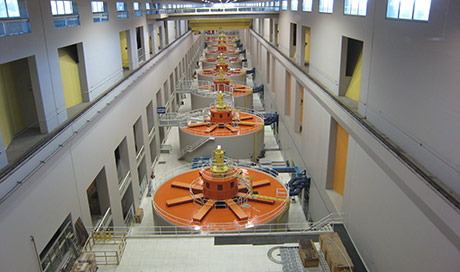People have been harnessing the power of water for centuries. The Greeks used water wheels to grind wheat more than 2,000 years ago. In the 1700s, water helped power the Industrial Revolution. And in 1882, the world’s first commercial hydroelectric power plant began serving customers in Appleton, Wisconsin.
Today, hydroelectric projects in the Columbia River Basin provide about 55 percent of the region’s energy needs.
Water + gravity = hydropower
Though there are a few different types of hydropower plants, they each
produce power in much the same way. As water flows through a powerhouse, the pressure of that falling water turns a large turbine that looks like a ship’s propeller. The spinning turbine turns a shaft that rotates a series of magnets past copper coils in a generator to create electricity. From the powerhouse, transmission lines carry electricity to communities, where local utilities distribute it to consumers.
Clean, renewable, affordable
Because they are powered by water, dams do not produce emissions like fossil-fuel burning resources, making the Northwest’s power system the cleanest in the nation. Replacing even 1,000 average megawatts of hydropower with a carbon dioxide-emitting, natural gas plant would bring more than 4 million metric tons of CO2 into the Northwest each year. Altogether, the Northwest’s federal and nonfederal dams produce 12,000 megawatts of firm hydropower, thereby avoiding roughly 50 million metric tons of carbon emissions each year.
Unlike coal, oil, nuclear or natural gas power plants, hydropower plants do not consume their fuel; the water simply spins a turbine as it passes downstream, unchanged. Every drop of water produces electricity as it flows through the turbines at each dam on its path to the ocean.
It’s also a renewable energy source, meaning its fuel is replenished naturally, thanks to the water cycle. And the fuel falls without charge from the sky, making hydropower one of the least expensive sources of energy.
Types of hydroelectric dams
Hydropower plants fall into two categories: run-of-river and storage. Run-of-river dams were developed primarily for navigation and hydropower generation. Water runs through these structures as it arrives at each dam. Storage dams have reservoirs behind them that can hold water to be released as needed. Generally, storage reservoirs are drawn down in winter and early spring to provide power and to make room for heavy spring runoff and prevent flooding downstream. With more than 60 dams in the Columbia River Basin, the operators work together to choreograph the system as if it were operated by a single owner, meeting the region’s needs in the most efficient way.
For information on programs and services visit www.franklinpud.com
Find more stories like these from our partners at BPA!

